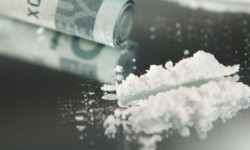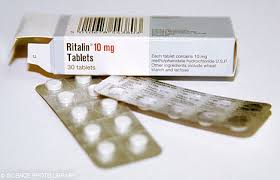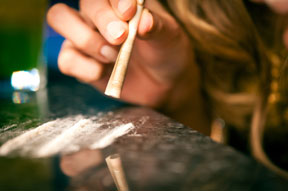List of Stimulant Drugs
Stimulants are dangerous drugs that are commonly abused by individuals looking to stay alert and focused, lose weight, stay awake, and get high. Although these drugs can be extremely harmful and even life-threatening, many of them can also be used to treat conditions like ADHD, narcolepsy, and in some cases, depression. There are many types of stimulant drugs, and it can be beneficial to know a little about each one, its purposes, and how harmful it can be when abused.
Illicit Stimulant Drugs

Cocaine is a popular illicit drug within stimulating effects.
Illicit stimulants are usually schedule II, depending on whether or not they can be used to treat medical conditions. While some variations of stimulants are schedule I drugs, most are extremely addictive and dangerous schedule II substances. These drugs are often abused in a binge-crash pattern. According to the NIDA Teen, “In order to keep the ‘high’ going, people may take the drug repeatedly within a short period of time, at increasingly higher doses.” This makes these drugs extremely addictive.
- Cocaine
- Street Names: “Coke, Snow, Snow White, Rock, Powder, Blow, Flake, Charlie, Yeyo (Spanish), Nose Candy, Johnny, Sugar, Toot, Happy Trails” (CESAR)
- Methods of Use: snorted (“sniffing the powder into the nasal passages”), intravenous injection, ingested orally, rubbed on the gums, sprinkled on cigarettes or marijuana joints
- Short-term Effects: a short high that lasts about 15 to 30 minutes, euphoria, anxiety, paranoia, restlessness, insomnia, increase in temperature, heart rate, and blood pressure
- Long-term Effects: addiction, headaches, stroke, hallucinations, damage to the nasal septum, heart disease, heart attack, psychosis, death
- Cocaine is highly addictive and dangerous. It is not used medically.
- Crack-cocaine
- Street Names: Crack, Rock, Base, Sugar Block, Kryptonite, Topo (Spanish), Apple Jacks, Hard Rock
- Methods of Use: smoked through a glass pipe, (less commonly) snorted, intravenous injection
- Short-term Effects: a short high that lasts about 5 to 10 minutes, increased breathing, “intense euphoria,” cravings, depression, decreased appetite, aggression, paranoia, addiction (CESAR)
- Long-term Effects: addiction, delirium, psychosis, brain seizures, stroke, respiratory failure, hallucinations, death
- Crack can become even more addictive than cocaine because of how quickly it reaches the brain.
- Methamphetamine
- Street Names: Meth, Crystal, Crystal Meth, Ice, Glass, Redneck Cocaine, Crank, Speed, Tina, Tick-Tock, Scootie, Yellow Barn/Powder, Hot Ice, Chalk
- Methods of Use: taken orally, smoked, snorted, intravenous injection
- Short-term Effects: euphoria, depression, dry mouth, loss of appetite, seizures, headache, increased physical activity, insomnia, paranoia, irritability, risky or dangerous behavior
- Long-term Effects: addiction, damage to the brain, high blood pressure, anxiety, paranoia, homicidal or suicidal tendencies, sores, cracked teeth, weak immune system, death
- Methamphetamine is sometimes used as a treatment for ADHD, but because the drug can cause so many dangerous side effects and sudden death when abused, it is not often prescribed medically (NIDA).
- Methylenedioxymethamphetamine (MDMA)
- Street Names: Ecstasy, Molly, E, X, XTC, ADAM, Rolls, Pills, Love Drug, Go
- Methods of Use: taken orally in tablet form
- Short-term Effects: euphoria, muscle tension, nausea, heat exhaustion, fainting, chills, sweating, anxiety, paranoia, intense empathy
- Long-term Effects: depression, paranoia, cravings, depletion of serotonin, death
- MDMA is associated with risky sexual behavior and many other issues that make it dangerous.
Illicit stimulant drugs are extremely dangerous and their abuse can often lead to extreme physical problems, psychological and cognitive damage that is often irreparable, and death. However, abusing prescription stimulants can also be extremely dangerous as well.
Prescription Stimulants
According to the NIDA, “Stimulant medications including amphetamines (e.g., Adderall) and methylphenidate (e.g., Ritalin and Concerta) are often prescribed to treat children, adolescents, or adults diagnosed with attention-deficit hyperactivity disorder (ADHD).” These drugs are sometimes used to treat other conditions and are available by prescription only because of how dangerous they can be when abused.
Even still, college students are actually known to abuse prescription stimulants more than any other group. According to a study from the NCBI, “Recent research has documented that these drugs are widely available on college campuses for nonmedical use, owing in part to their pharmacologic properties as stimulant drugs.” Some students just use them to get high while others hope they will be able to focus more and function without sleep in order to do better in school. Research actually shows, though, that students who abuse prescription drugs do worse in school than students who don’t.
- Amphetamines
- Types of Amphetamines: amphetamine, lisdexamfetamine, dextroamphetamine, levoamphetamine,
- Brand Names: Biphetamine, Dexedrine, Adderall, Vyvanse
- Street Names: Black Beauties, Truck Drivers, Uppers, Speed, LA Turnaround, Hearts, Copilots, Eye-openers, Lid Poppers, Crosses, Bennies
- Methods of Use: taken orally, crushed and smoked, snorted, injected
- Short-term Effects: increase in energy, increase in heart rate, increase in blood pressure, insomnia, seizures, alertness, “dangerously high body temperature” (NIDA Teen)
- Long-term Effects: addiction, stroke, an inability to feel pleasure, depression, cravings, ulcers, repetitive motor activity, cardiac arrhythmias, mental illness, malnutrition, death
- According to CESAR, “Abuse of amphetamines, which can lead to tolerance and physical and psychological dependence, is characterized by consuming increasingly higher dosages, and by the ‘binge and crash’ cycle.”
- Methylphenidate
- Brand Names: Concerta, Methylin, Ritalin
- Street Names: Vitamin R, The Smart Drug, Skippy, JIF
- Methods of Use: snorted, injected, taken orally
- Short-term Effects: similar to those caused by amphetamines
- Long-term Effects: similar to those caused by amphetamines
- Methylphenidate is just as dangerous as amphetamines are when abused and are is addictive in nature.
Prescription stimulants can be dangerous to those who abuse them, causing many physical and mental issues that do not subside quickly and can sometimes last several months or longer. While this is true, when prescription stimulants are not abused, they can be part of a beneficial treatment plan for individuals with severe ADHD and other medical conditions.
Other Stimulants
There are other stimulants that may not be as dangerous and often can be overlooked. However, it is important to know that they are in the same category as these drugs because they may trigger someone with a stimulant addiction. These are:
- Caffeine
- Coca
- Nicotine (found in tobacco)
- Tea
Stimulant substances can range from giving a individual a relatively harmless boost to being deadly and extremely dangerous. All stimulants can be somewhat addictive if taken in excess, and this can be very problematic for individuals who begin to abuse harmful stimulant drugs.



